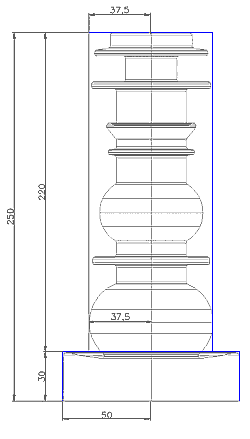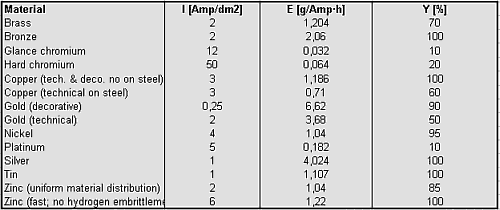
© 1998 Torben Lenau
Disclaimer: This page is made for teaching purposes, and we accept no responsibility for the correctness of the data given.
The cost for electroplating an object is determined by:
Here follows a short description of a procedure for thecalculation of an estimate for electroplating costs.
The whole procedure for calculation is documented in thefollowing example that can be downloaded as an
Example
This example is based on silver plating of 100 newcandlesticks as that shown in the picture.
Main dimensions: height: 250 mm; lower base radius: 50 mm; upperbase radius: 20 mm.
 |
|
The cost of material depends on two different variables:
The first depends on the quotations of metal prices, while thelatter depends on the density of the material, the coatingthickness and the surface area of the object to be coated.
The cost of the coating material [DKK/part] can be calculated bythe formula:
| Cm= p ·qm ·S ·t | p = price of the coating material [DKK/g] qm= density of the material [g/dm2·µm] S = surface area [dm2/part] t = coating thickness [µm] |
Metal prices and densities are standardvalues, which can be easily found from many sources.
Average quotations are taken from different possible sources suchas: "
Density in [g/dm2·µm] can be obtained multiplyingthe common value for densities in [g/cm3]by 0.01). Coating thickness varies, according tothe plating process and the purpose, within standard ranges.Standard values for these three variables can be found in thefollowing table:

Finally, the surface area of the object to be coatedcan be estimated by approximating the shape of the object with aseries of circumscribed boxes, whose surface area can be moreeasily calculated.
Example
Following the case shown in the figure:
Price of material (silver): 1400 DKK/kg
Density of the material (silver): 10.5 [g/cm3]
Coating thickness: 13 µm
In this case the shape of the object can be approximated usingtwo squared base boxes (100 x 100 x 30 and 75 x 75 x 220). Thewhole surface of the lower box and the lateral surface of theupper box are included, disregarding the top and bottom of theupper box. The value obtained is:
S = 4·100·30 + 2·100·100 + 4·75·220 = 98,000 mm2
With this data, from the formula above:
Cm= 1.4·0.105·9.8·13 = 18.73 DKK/part
Labour cost also depends on two different variables:
Throughput time includes plating time and set-up time. Platingtime is the time required to plate the part and corresponds tothe immersion time. The set up time includes the time spent toprepare the part, to change the baths or electrodes, and forpossible post processing.
The hourly cost of labour depends on an average cost of labour,which includes workers wages, overheads and profit. The hourlyvalues for these parameters can be empirically estimated to beabout 100 DKK/h each. This gives an hourly cost of labour of 300DKK/h. But actually, the workers use all their time only duringset-ups, while during the plating time they can perform otheractivities. Therefore, the hourly cost of labour can bedecomposed in two components: one related to the plating time (
Cases requiring very thin coating layers (e.g. sometimes goldpalting) are exceptions, because, due to the extremely shortimmersion time, the worker is constantly occupied to check thebath. Therefore, in such cases the hourly cost of labour will be300 DKK/h.
With the parameters set, the labour cost can be calcualted bythe formula below:
Cl= [w1·n·Tb+ w2·ta·q)]/(q·60
The number of baths (n) required for plating a batch of (q)parts can be calculated as follows:
n = (S·q)/ b
b is the bath content capacity in dm2,empirically estimated to be one tenth of the bath size in litres(b = 0.1 · bath size, with bath size in litres).
Bath sizes depend on the type of production (local, industrial)and are basically standard too. Within both local and industrialproduction the sizes of baths is not fixed and vary withintypical ranges. Common minimum and maximum sizes are shown in thefollowing table:

If the size of the bath is known, the calculation is performedusing this value. If unknown, two different calculations will beperformed, one using the minumum and the other using the maximumbath size. This allows to set an upper and a lower estimate ofthe plating cost.
The bath time Tb [min] iscalculated as follows:
| Tb= (t·dm·60)/(I·E·Y) | t = coating thickness [µm] dm= density of the material[g/cm3] I = current intensity [Amp/dm2] E = electrostatic equivalent[g/Amp·h] Y = current yield [%] |
Values for I, E, Y depend on the process and the purpose, andvary within standard ranges. Typical values are shown in thetable below.

Finally, the set-up time ta[min/part] depends on the part’s size, the type ofproduction (local, industrial), and the size of the productionbatch. Standard values for tacan be found in the following table:

Example
Continuing the example shown:
Hourly wage:
w1= 300 DKK/h
w2= 150 DKK/h
Max bath size: 4000 litres; Max bath capacity bmax= 400 dm2
Min bath size: 200 litres; Min bath capacity bmin = 20dm2
Min number of baths required nmin = 9.8·100/400 =2.45
Max number of baths required nmax = 9.8·100/20 = 49
Current intensity (I): 1 Amp/dm2
Electrostatic equivalent (E):4.024 g/Amp·h
Current yield (Y): 100%
From these data follows the bath time:
Tb=(13·10.5·60)/(1·4.024·100) = 20.35 min
Batch size = 100 parts
Set-up time ta = 3 min/part
Labour cost
Min labour cost Clmin = [300·2.45·20.35 + 150·100·3)]/100·60= 9.99 DKK/part
Max labour cost Clmax = [300·49·20.35 + 150·100·3)]/100·60= 57.36 DKK/part
The amortization of the equipment [DKK/part] is allocated tothe part according to its throughput time using an hourly cost ofthe equipment (we).
Ce = [we·(n·Tb+ q·ta)]/(q·60
The calculation of all the other parameters in the formula hasbeen shown in the previous paragraph.
Example
Hourly cost of the equipment: 35 DKK/h
Min equipment cost Cemin = [35·(2.45·20.35+ 100·3)]/100·60 = 2.04 DKK/part
Max equipment cost Cemax = [35·(49·20.35+ 100·3)]/100·60 = 7.56 DKK/part
Total cost
The total cost [DKK/part] is the sum of the three previouslycalculated costs.
Ct = Cm +Cl + Ce
Example
Summing material, labour and equipment costs:
Ctmin = 18.73 + 9.99 + 2.04 = 30.76 DKK/part
Ctmax = 18.73 + 57.36+ 7.57 = 83.66 DKK/part
For automatic calculation of the estimate of costs of anyelectroplating processes, using the method exposed, download thefollowing excel-file (version 7.0).